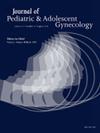12. Needle-less Local Anesthetic Device for Subcutaneous Etonogestrel Insertion
IF 1.7
4区 医学
Q3 OBSTETRICS & GYNECOLOGY
引用次数: 0
Abstract
Background
The subcutaneous etonogestrel implant is a first-line option for long-acting reversible contraceptive in adolescents but is often avoided due to fear of procedural pain. This early randomized control trial aimed to evaluate how a novel, needle-less device (J-Tip TM) for local anesthesia affected pain perception and overall patient satisfaction during implant insertion.
Methods
This IRB approved study recruited adolescents 13-21 years of age interested in the etonogestrel implant. Participants were randomized to receive intradermal lidocaine via the needle-less device or the traditional needle-based approach (control group). They were asked to complete a modified Amsterdam Preoperative Anxiety and Information Scale before and after the procedure and to report their pain scores via a 10-point Visual Analogue Scale throughout the procedure. Demographic and basic medical information were collected. Statistical analysis included student t-tests, correlation analysis, and effect size analysis with Cohen's d.
Results
Twenty-three participants were consented (11 controls and 12 interventions). Both groups had similar demographics and pre-procedure anxiety levels. Most were 16 years of age and denied having pre-existing mood disorders. Pain scores during lidocaine injection were significantly higher in the control group compared to the intervention group (mean = 5.8 ± 2.0 vs 0.8 ± 1.3, p< 0.001, range = 3-9 vs 0-3, d = 2.95). Pain scores during Nexplanon insertion were significantly lower in the control group compared to the intervention group (mean= 0.8 ± 0.9 vs 4.1 ± 2.5, p < 0.001, range = 0-2 vs range = 1-8, d = -1.81). In the post-procedure survey, recalled pain during insertion and overall satisfaction with the procedure among patients, parents and providers were not significantly different. Pre-procedure anxiety and expecting the procedure to be uncomfortable were positively correlated with increased stress during the procedure (r = 0.6, r=0.45) but not significantly correlated with any pain scores during the procedure.
Conclusions
While the new device may effectively reduce pain during administration of local anesthesia, its efficacy compared to traditional needle-based injection methods prior to implant insertion warrants further investigation. Our findings also emphasize the importance of managing patient expectations regarding comfort and pain, which may enhance overall satisfaction and reduce perceived pain and stress during the procedure. This study serves as a pilot to inform a larger randomized controlled trial aimed at improving the patient experience during etonogestrel implant insertions.
12. 依诺孕酮皮下注射用无针局麻装置
背景:炔诺孕酮皮下植入是青少年长效可逆避孕的一线选择,但由于害怕手术疼痛而经常被避免。这项早期随机对照试验旨在评估一种用于局部麻醉的新型无针装置(J-Tip TM)如何影响植入期间患者的疼痛感知和总体满意度。方法本研究经IRB批准,招募对依替诺孕酮植入感兴趣的13-21岁青少年。参与者被随机分为两组,一组通过无针装置皮下注射利多卡因,另一组通过传统的针刺方法皮下注射利多卡因(对照组)。他们被要求在手术前后完成修改后的阿姆斯特丹术前焦虑和信息量表,并在整个手术过程中通过10分视觉模拟量表报告他们的疼痛评分。收集人口统计和基本医疗信息。统计分析包括学生t检验、相关分析和效应量分析(Cohen’s d.)。结果共23名被试获得同意(11名对照和12名干预)。两组的人口统计数据和术前焦虑水平相似。大多数人都是16岁,并否认自己先前患有情绪障碍。对照组注射利多卡因时疼痛评分明显高于干预组(平均 = 5.8±2.0 vs 0.8±1.3,p<;0.001,范围 = 3-9 vs 0-3, d = 2.95)。对照组插入Nexplanon时疼痛评分明显低于干预组(平均= 0.8±0.9 vs 4.1±2.5,p <;0.001,范围 = 0-2 vs范围 = 1-8,d = -1.81)。在术后调查中,患者、家长和提供者对插入时疼痛的回忆和对手术的总体满意度无显著差异。术前焦虑和预期手术不舒服与手术过程中压力增加呈正相关(r = 0.6,r=0.45),但与手术过程中的任何疼痛评分均无显著相关。结论虽然新型装置可以有效减轻局部麻醉时的疼痛,但与传统的植入前针头注射方法相比,其效果有待进一步研究。我们的研究结果还强调了管理患者对舒适和疼痛的期望的重要性,这可能会提高整体满意度,减少手术过程中的疼痛和压力。本研究为一项旨在改善依替诺孕酮植入过程中患者体验的更大的随机对照试验提供先导。
本文章由计算机程序翻译,如有差异,请以英文原文为准。
求助全文
约1分钟内获得全文
求助全文
来源期刊
CiteScore
3.90
自引率
11.10%
发文量
251
审稿时长
57 days
期刊介绍:
Journal of Pediatric and Adolescent Gynecology includes all aspects of clinical and basic science research in pediatric and adolescent gynecology. The Journal draws on expertise from a variety of disciplines including pediatrics, obstetrics and gynecology, reproduction and gynecology, reproductive and pediatric endocrinology, genetics, and molecular biology.
The Journal of Pediatric and Adolescent Gynecology features original studies, review articles, book and literature reviews, letters to the editor, and communications in brief. It is an essential resource for the libraries of OB/GYN specialists, as well as pediatricians and primary care physicians.

 求助内容:
求助内容: 应助结果提醒方式:
应助结果提醒方式:


